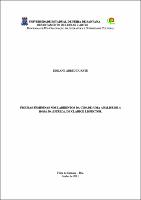| Compartilhamento |


|
Use este identificador para citar ou linkar para este item:
http://tede2.uefs.br:8080/handle/tede/1125Registro completo de metadados
| Campo DC | Valor | Idioma |
|---|---|---|
| dc.creator | Duarte, Edilane Abreu | - |
| dc.creator.Lattes | http://lattes.cnpq.br/7074419591809383 | por |
| dc.contributor.advisor1 | Ribeiro Patrício, Rosana Maria | - |
| dc.date.accessioned | 2020-05-15T22:35:25Z | - |
| dc.date.issued | 2011-06-20 | - |
| dc.identifier.citation | DUARTE, Edilane Abreu. Figuras femininas nos labirintos da cidade: uma análise de A Hora da Estrela, de Clarice Lispector. 2011. 86 f. Dissertação (Mestrado Acadêmico em Literatura e Diversidade Cultural)- Universidade Estadual de Feira de Santana, Feira de Santana, 2011. | por |
| dc.identifier.uri | http://tede2.uefs.br:8080/handle/tede/1125 | - |
| dc.description.resumo | Essa dissertação apresenta o exame das representações das figuras femininas do romance A Hora da estrela, de Clarice Lispector, nos labirintos da cidade do Rio de Janeiro, trazendo uma abordagem acerca do modo como essas mulheres se deslocam na grande metrópole e como a experiência urbana interfere nas ações das personagens. O texto ficcional é analisado considerando-se as suas relações com a sociedade que representa, levando-se em conta as questões que envolvem a presença da mulher na cena social da vida na cidade, questões estas que são problematizadas na ficção lispectoriana. Assim sendo, elementos externos da vida na metrópole são incorporados à cena ficcional de A Hora da estrela, narrativa que retrata a experiência urbana em forma de um binômio de dupla implicação: a cidade é ao mesmo tempo polo de atração e de repúdio, paradoxalmente uma utopia e um inferno. Nesta obra a autora realiza uma denúncia social acerca da condição da migrante nordestina Macabéa na grande metrópole, trazendo à tona o retrato de uma sociedade cruel e indiferente. Apresenta-nos, também, outras figuras femininas como Glória e Madama Carlota, mulheres que percorrem os labirintos da cidade e neles vão tecendo os acontecimentos de suas vidas. Tal narrativa se compõe, portanto, de imagens da ruína das relações humanas perante o monstruoso progresso da tecnologia e dos ideais da produtividade do sistema capitalista, nos mostrando que o processo de modernização gerou megalópoles problemáticas, em crise, atravessadas pela violência, pela desestabilização de valores, pela lógica da exclusão e pela perda de laços comunitários. | por |
| dc.description.abstract | This thesis presents an examination of representations of female figures in the novel The Hour of the Star by Clarice Lispector, in the labyrinths of the city of Rio de Janeiro, bringing an approach on how these women moving in the great metropolis and how the urban experience interferes the actions of the characters. The fictional text is analyzed considering its relations with the society it represents, taking into account the issues surrounding women's presence in the social scene of city life, these issues are issues in the fiction lispectoriana. Thus, the external elements of life in the metropolis are incorporated into the fictional scene of The Hour of the star, the narrative that depicts the urban experience in the form of a binomial double implication: the city is simultaneously a pole of attraction and rejection, a paradoxically utopia and hell. In this book the author makes a complaint about the social status of migrant in northeastern Macabéa metropolis, revealing portrait of a cruel and indifferent society. Presents us, too, other figures such as Gloria and Madama Carlota, women going through the mazes of the city and they weave the events of their lives. This narrative is composed, therefore, images of the destruction of human relationships to the monstrous progress in technology and productivity of the ideals of the capitalist system, showing us that the process of modernization has generated megalopolis problematic in crisis, crossed by violence, destabilization of values, by the logic of exclusion and loss of community ties. | eng |
| dc.description.provenance | Submitted by Ricardo Cedraz Duque Moliterno (ricardo.moliterno@uefs.br) on 2020-05-15T22:35:25Z No. of bitstreams: 1 DISSERTAÇÃO EDILANE DUARTE.pdf: 687948 bytes, checksum: d97dbaccc54569d22f5b64a0935067f7 (MD5) | eng |
| dc.description.provenance | Made available in DSpace on 2020-05-15T22:35:25Z (GMT). No. of bitstreams: 1 DISSERTAÇÃO EDILANE DUARTE.pdf: 687948 bytes, checksum: d97dbaccc54569d22f5b64a0935067f7 (MD5) Previous issue date: 2011-06-20 | eng |
| dc.format | application/pdf | * |
| dc.thumbnail.url | http://tede2.uefs.br:8080/retrieve/6129/DISSERTA%c3%87%c3%83O%20EDILANE%20DUARTE.pdf.jpg | * |
| dc.language | por | por |
| dc.publisher | Universidade Estadual de Feira de Santana | por |
| dc.publisher.department | DEPARTAMENTO DE LETRAS E ARTES | por |
| dc.publisher.country | Brasil | por |
| dc.publisher.initials | UEFS | por |
| dc.publisher.program | Mestrado Acadêmico em Literatura e Diversidade Cultural | por |
| dc.rights | Acesso Aberto | por |
| dc.subject | Cidade | por |
| dc.subject | Literatura | por |
| dc.subject | Mulher | por |
| dc.subject | Relações humanas | por |
| dc.subject | City | eng |
| dc.subject | Human relations | eng |
| dc.subject | Literature | eng |
| dc.subject | Women | eng |
| dc.subject.cnpq | LETRAS::LITERATURA BRASILEIRA | por |
| dc.title | Figuras femininas nos labirintos da cidade: uma análise de A Hora da Estrela, de Clarice Lispector | por |
| dc.type | Dissertação | por |
| Aparece nas coleções: | Coleção UEFS | |
Arquivos associados a este item:
| Arquivo | Descrição | Tamanho | Formato | |
|---|---|---|---|---|
| DISSERTAÇÃO EDILANE DUARTE.pdf | Arquivo em texto completo. | 671,82 kB | Adobe PDF |  Baixar/Abrir Pré-Visualizar |
Os itens no repositório estão protegidos por copyright, com todos os direitos reservados, salvo quando é indicado o contrário.




